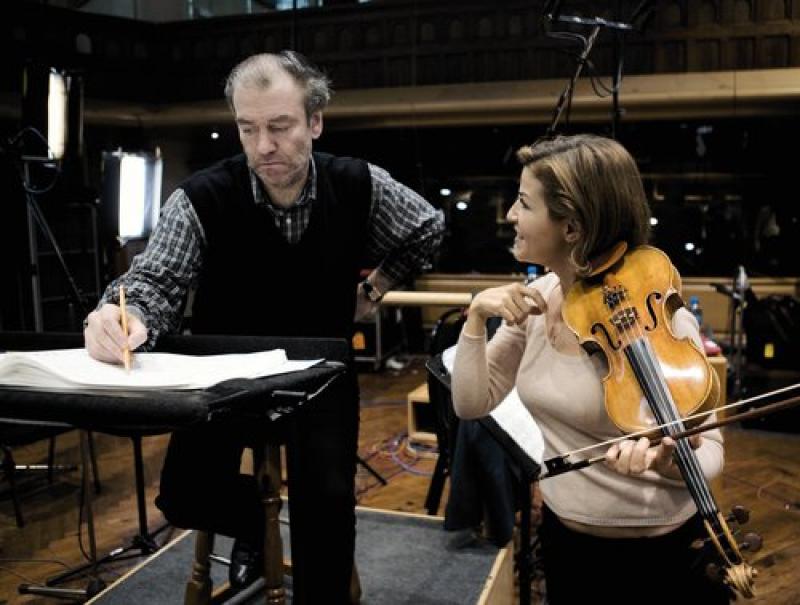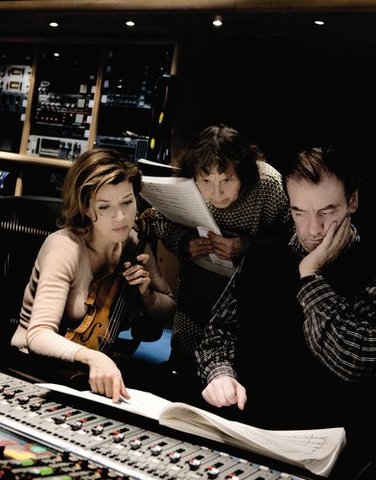Mutter, London Symphony Orchestra, Gergiev, Barbican Hall | reviews, news & interviews
Mutter, London Symphony Orchestra, Gergiev, Barbican Hall
Mutter, London Symphony Orchestra, Gergiev, Barbican Hall
A hard-hitting double bill of two Russian masterworks over 50 years apart

Praise be, or slava if you prefer, to Valery Gergiev for honouring new Russian music alongside his hallmark interpretations - ever evolving or dangerously volatile according to taste – of Prokofiev, Shostakovich and Stravinsky. Last LSO season featured some of the less than inspired recent works Rodion Shchedrin has been dredging by the yard. Yet few would begrudge the palm of deep and original musical thought to this past week’s heroine, Sofia Gubaidulina.
In tempus praesens bends the "present time" it purports to be all about with unstable interchanges between soloist and kaleidoscopic, unpredictable orchestral groups. The courage of Mutter's ardent solo violin at the start with its intense, human vibrato sometimes takes a battering from the heavier scoring - though the singular colour of the three Wagner tubas fleetingly present couldn't really be detected - and several times is silenced by the oracular "enough" of a giant tam-tam, struck by a player with his back to the massive instrument.
 An intensely beautiful, chorale-like weave between soloist and woodwind is brushed aside by manic flights and monster-toybox rattles taking up where Shostakovich, another great innovator with the percussion battery, left off; a relentless three-note string tattoo urged by Gergiev with his usual insistence on fullness of sound finally ushers in a big cadenza before a final metaphysical soaring.
An intensely beautiful, chorale-like weave between soloist and woodwind is brushed aside by manic flights and monster-toybox rattles taking up where Shostakovich, another great innovator with the percussion battery, left off; a relentless three-note string tattoo urged by Gergiev with his usual insistence on fullness of sound finally ushers in a big cadenza before a final metaphysical soaring.
One Russian cellist told me he saw the end of Prokofiev's Symphony-Concerto as the Russian image of the soul squeezing in to heaven through the eye of a needle, as it were, and that's how Gubaidulina's strange adventure (the composer pictured above with Mutter and Gergiev) seemed to end. And adventure it was, moving forward through space - or certainly seeming to do so through Mutter's urgent interaction with Gergiev's ever-vivid LSO - in a way that few contemporary pieces genuinely achieve, and stocked with enough ideas for half a dozen works by a lesser composer. This is a concerto that's here to stay.
Collectively, the woodwind plumb unison depth of tone that few achieve in Shostakovich's whirlwind Scherzo
Nearly 60 years on, there's no doubt about the status of Shostakovich's 10th Symphony, one of the most monumentally entrenched in the repertoire out of the 15. Gergiev's latest way with a work he knows inside out no longer favours much brooding atmosphere - slow introduction to the finale excepted - nor colossal tragedy, only a mastery that understands how every corner must be turned, and how to communicate that turning with the finest nuance to the players.
Collectively, the woodwind plumb unison depth of tone that few achieve in the whirlwind Scherzo - which may, or may not, be an evocation of Stalin's terror years looking back from the temporary release of 1953 - but they’re equally impressive as individuals. If you had to slice into the interpretation for the truest evidence of Gergiev’s moulding, it would probably be for the combination of ravishing tone colours from flute and softest pizzicato in the limping waltz that ever so cautiously lifts the laments of the first movement.
Yet every solo brought its fine-etched personality, culminating in the personal pleas of Nora Cismondi's oboe and Rachel Gough's bassoon, both superlative, before the clouds lift for what in this case was an unequivocally springy final romp. As the years pass, we come to hear Shostakovich's symphonies as flawless constructions not necessarily freighted with the horrors of his times, and in that respect Gergiev seems to have loosened up as much as many of his younger fellow conductors. But then next time his Shostakovich 10 will probably sound different again.
Share this article
The future of Arts Journalism
You can stop theartsdesk.com closing!
We urgently need financing to survive. Our fundraising drive has thus far raised £49,000 but we need to reach £100,000 or we will be forced to close. Please contribute here: https://gofund.me/c3f6033d
And if you can forward this information to anyone who might assist, we’d be grateful.

Subscribe to theartsdesk.com
Thank you for continuing to read our work on theartsdesk.com. For unlimited access to every article in its entirety, including our archive of more than 15,000 pieces, we're asking for £5 per month or £40 per year. We feel it's a very good deal, and hope you do too.
To take a subscription now simply click here.
And if you're looking for that extra gift for a friend or family member, why not treat them to a theartsdesk.com gift subscription?
more Classical music
 Bizet in 150th anniversary year: rich and rare French offerings from Palazzetto Bru Zane
Specialists in French romantic music unveil a treasure trove both live and on disc
Bizet in 150th anniversary year: rich and rare French offerings from Palazzetto Bru Zane
Specialists in French romantic music unveil a treasure trove both live and on disc
 Scottish Chamber Orchestra, Ibragimova, Queen’s Hall, Edinburgh review - rarities, novelties and drumrolls
A pity the SCO didn't pick a better showcase for a shining guest artist
Scottish Chamber Orchestra, Ibragimova, Queen’s Hall, Edinburgh review - rarities, novelties and drumrolls
A pity the SCO didn't pick a better showcase for a shining guest artist
 Kilsby, Parkes, Sinfonia of London, Wilson, Barbican review - string things zing and sing in expert hands
British masterpieces for strings plus other-worldly tenor and horn - and a muscular rarity
Kilsby, Parkes, Sinfonia of London, Wilson, Barbican review - string things zing and sing in expert hands
British masterpieces for strings plus other-worldly tenor and horn - and a muscular rarity
 From Historical to Hip-Hop, Classically Black Music Festival, Kings Place review - a cluster of impressive stars for the future
From quasi-Mozartian elegance to the gritty humour of a kitchen inspection
From Historical to Hip-Hop, Classically Black Music Festival, Kings Place review - a cluster of impressive stars for the future
From quasi-Mozartian elegance to the gritty humour of a kitchen inspection
 Shibe, LSO, Adès, Barbican review - gaudy and glorious new music alongside serene Sibelius
Adès’s passion makes persuasive case for the music he loves, both new and old
Shibe, LSO, Adès, Barbican review - gaudy and glorious new music alongside serene Sibelius
Adès’s passion makes persuasive case for the music he loves, both new and old
 Anja Mittermüller, Richard Fu, Wigmore Hall review - a glorious hall debut
The Austrian mezzo shines - at the age of 22
Anja Mittermüller, Richard Fu, Wigmore Hall review - a glorious hall debut
The Austrian mezzo shines - at the age of 22
 First Person: clarinettist Oliver Pashley on the new horizons of The Hermes Experiment's latest album
Compositions by members of this unusual quartet feature for the first time
First Person: clarinettist Oliver Pashley on the new horizons of The Hermes Experiment's latest album
Compositions by members of this unusual quartet feature for the first time
 Gesualdo Passione, Les Arts Florissants, Amala Dior Company, Barbican review - inspired collaboration excavates the music's humanity
At times it was like watching an anarchic religious procession
Gesualdo Passione, Les Arts Florissants, Amala Dior Company, Barbican review - inspired collaboration excavates the music's humanity
At times it was like watching an anarchic religious procession
 Classical CDs: Camels, concrete and cabaret
An influential American composer's 90th birthday box, plus British piano concertos and a father-and-son duo
Classical CDs: Camels, concrete and cabaret
An influential American composer's 90th birthday box, plus British piano concertos and a father-and-son duo
 Cockerham, Manchester Camerata, Sheen, Martin Harris Centre, Manchester review - re-enacting the dawn of modernism
Two UK premieres added to three miniatures from a seminal event of January 1914
Cockerham, Manchester Camerata, Sheen, Martin Harris Centre, Manchester review - re-enacting the dawn of modernism
Two UK premieres added to three miniatures from a seminal event of January 1914
 Kempf, Brno Philharmonic, Davies, Bridgewater Hall, Manchester review - European tradition meets American jazz
Bouncing Czechs enjoy their Gershwin and Brubeck alongside Janáček and Dvořák
Kempf, Brno Philharmonic, Davies, Bridgewater Hall, Manchester review - European tradition meets American jazz
Bouncing Czechs enjoy their Gershwin and Brubeck alongside Janáček and Dvořák
 Solomon, OAE, Butt, QEH review - daft Biblical whitewashing with great choruses
Even a top soprano and mezzo can’t make this Handel paean wholly convincing
Solomon, OAE, Butt, QEH review - daft Biblical whitewashing with great choruses
Even a top soprano and mezzo can’t make this Handel paean wholly convincing

Add comment